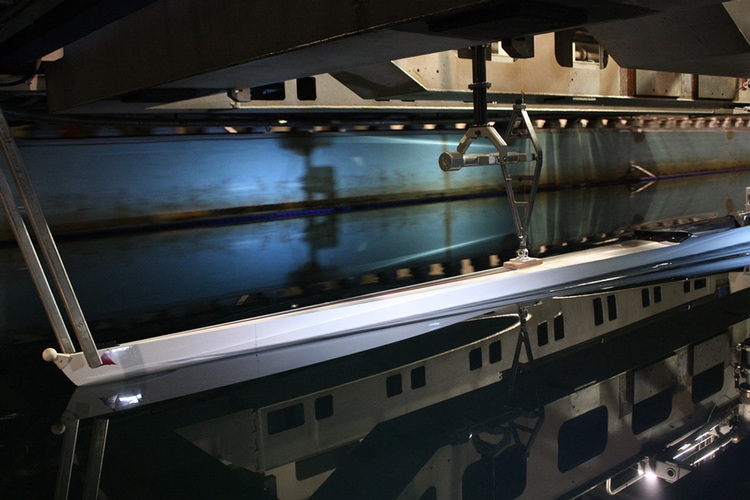What is Hydrodynamic Lift, and how does it affect my rowing?
Steve Killing, Designer for Hudson Boat Works

The term hydrodynamic lift is not something I hear in casual conversation around the boathouse, and consequently I thought we should rephrase the question before tackling the answer. Hydro is water, Dynamic refers to motion, and Lift is a force, perpendicular to the direction of motion (in the case of rowing boats, vertical). So the question could be further interpreted as "When I am rowing at race pace, what forces are acting on the hull, and how can that knowledge be used to maximize speed?"
When a boat is moving through water two things will change - the trim (bow up or down), and the sink (an unfortunate term, but it refers to whether the boat's center of gravity rises or sinks vertically). These changes to the boat's attitude in the water are a result of the varying pressure on the underwater surface of the hull, combined with the wave form developed along the side of the boat (you can see the waveform in the towing tank photo above). The faster you go, the more the bow will rise and the stern drop while overall the boat "sinks" in the water.
If you want to relate that directly to the term "hydrodynamic lift", the boat is subject to an upward force (positive lift) near the bow and a downward force (negative lift) near the stern due to the motion of the water past the hull.
There are various computer programs that calculate how trim varies with speed, and we have made use of both the simple and the complex in our assessment of rowing shells. The simpler programs use empirical formulae or wave and drag theories to calculate both drag and trim changes, while the more complex use unsteady CFD (computational fluid dynamics) that calculate from basic principles the motion of the shell as it varies speed and trim with each stroke. Each has its merits, cost, and time requirements and we choose the software to best meet the task at hand.

In order to gain faith in the computer software, we have confirmed the sink and trim of some or our shells in the towing tank. The plot shown here is the towing tank output on a full size shell and has a few interesting points. Whether you are racing at 4.5 or 5.5 metres per second, the trim for this particular shell is fairly constant at about 12 mm bow up (and the stern would be about 12 mm stern down). And that value is something you, the rower, and we, the designers, can make use of.
Although the boat changes its pitch due to your cyclical stroke, on average, for maximum speed, we want the boat to run level. So before you leave the dock, the boat should be 12 mm bow down, so that at speed the hydrodynamic effects will trim the boat level.
We, and we presume other manufacturers, have already located the cockpit to give you that bow down trim at the dock and you can influence it further with crew placement. The crew's location can easily be varied by moving the riggers, and foot stops fore or aft depending on the desired trim outcome.
The sink which shows on this plot to be about 5 mm for the shell analyzed, is something you won't be able to discern on the water and it is also something you can't influence. There are two separate effects that cause the shell to sink lower as it is rowed. The first is the waveform along the side of the boat which has a trough near the mid length of the hull. With the surface of the water lowered where the shell has the majority of its beam and buoyancy, the boat sinks correspondingly. The second reason comes back to the discussion of lift. If water passes with some speed over a curved surface there will be a force created in the direction of positive curvature. In our case the accelerated water flow under the hull creates a downward force (Bernoulli's Principle) and the faster the shell goes the larger the downward force.
Hydrodynamic forces, due to the motion of the boat through the water will lift the bow and drop the stern and since the goal is to have the boat nominally level at race pace, you will want some bow down trim at the dock for maximum performance. Your foot stretchers and riggers should be adjusted so that the boat is slightly bow down at the dock and at training pace, but level at race pace.
Steve Killing
Designer for Hudson Boat Works

If you enjoy and rely on row2k, we need your help to be able to keep doing all this. Though row2k sometimes looks like a big, outside-funded operation, it mainly runs on enthusiasm and grit. Help us keep it coming, thank you! Learn more.
Comments | Log in to comment |
- Bont Rowing
- Calm Waters Rowing
- Concept 2
- Craftsbury Sculling
- The Crew Classic
- CrewLAB
- Croker
- Dad Vail Regatta
- Durham Boat Co.
- Empacher
- Faster Masters
- Filippi
- Fluidesign
- h2row.net
- HUDSON
- Live2Row Studios
- Nielsen-Kellerman
- Oak Ridge RA
- Peinert Boat Works
- Pocock Racing Shells
- Race1 USA
- RowKraft
- Rubini Jewelers
- Vespoli USA
- WinTech Racing
- Bont Rowing
- Calm Waters Rowing
- Concept 2
- Craftsbury Sculling
- The Crew Classic
- CrewLAB
- Croker
- Dad Vail Regatta
- Durham Boat Co.
- Empacher
- Faster Masters
- Filippi
- Fluidesign
- h2row.net
- HUDSON
- Live2Row Studios
- Nielsen-Kellerman
- Oak Ridge RA
- Peinert Boat Works
- Pocock Racing Shells
- Race1 USA
- RowKraft
- Rubini Jewelers
- Vespoli USA
- WinTech Racing


















04/18/2016 12:29:07 AM
04/15/2016 3:34:19 AM
04/03/2016 10:51:44 AM
04/06/2016 10:41:48 AM
04/02/2016 10:15:14 PM
04/06/2016 10:42:23 AM
03/31/2016 1:31:08 PM
04/06/2016 10:43:37 AM